
After an illness, surfaces may still carry germs that can infect others. Proper cleaning ensures those lingering bacteria and viruses are eliminated to reduce the risk of spreading.
This cleaning is not just about tidying up—it involves targeted disinfecting. Germs can survive on surfaces for hours or even days, so thorough sanitation matters for everyone’s well-being.
Regular post-illness cleaning supports quicker recovery and keeps vulnerable household members safer. It also helps maintain hygiene habits that can prevent future outbreaks.
Focus on areas like doorknobs, remotes, switches, handles, and phones. These high-touch points often carry the most germs and should be disinfected multiple times during recovery.
Use disinfectant wipes or sprays approved to kill bacteria and viruses. Follow the label directions, especially regarding how long the cleaner should sit before wiping.
Pay attention to kitchen counters, faucet handles, and bathroom surfaces too. These spaces are hotspots for germ transmission and require extra attention.
Bed sheets, pillowcases, and towels must be washed in hot water. High temperatures kill viruses and remove body fluids that may carry germs. Always wear gloves if possible.
Add a disinfectant or laundry sanitizer to the wash cycle for extra protection. Dry items on high heat, as cold air does not kill all pathogens.
Soft surfaces like blankets or stuffed toys should be washed too. If not washable, spray with fabric-safe disinfectants or isolate for a few days.
Open windows to bring in fresh air and reduce indoor contaminants. Air circulation helps disperse lingering viruses and improves overall air quality during and after sickness.
Consider using air purifiers with HEPA filters for added protection. These can capture airborne particles, including viruses, and improve indoor health.
Disinfect floors, especially where children or pets play. Mop with a solution that eliminates germs, and avoid just spreading dirt around with plain water.
Throw away tissues, paper towels, and disposable masks right away. Use covered bins and empty them daily to prevent the spread of illness.
Clean and disinfect trash cans after sickness ends. Wipe lids, handles, and inner surfaces using a powerful disinfectant and wear gloves while handling waste.
Handwashing remains essential. Wash hands for at least 20 seconds after cleaning or touching potentially contaminated items. Always keep sanitizer available.
Begin as soon as the person is feeling better to prevent reinfection or spread to others.
Use EPA-approved disinfectants or diluted bleach solutions for effective germ-killing.
Natural products are good for maintenance but not always strong enough for disinfection.
Yes, disinfect phones, remotes, and keyboards with wipes or sprays safe for electronics.
Wear gloves and a mask if possible, and always wash hands after each cleaning session.